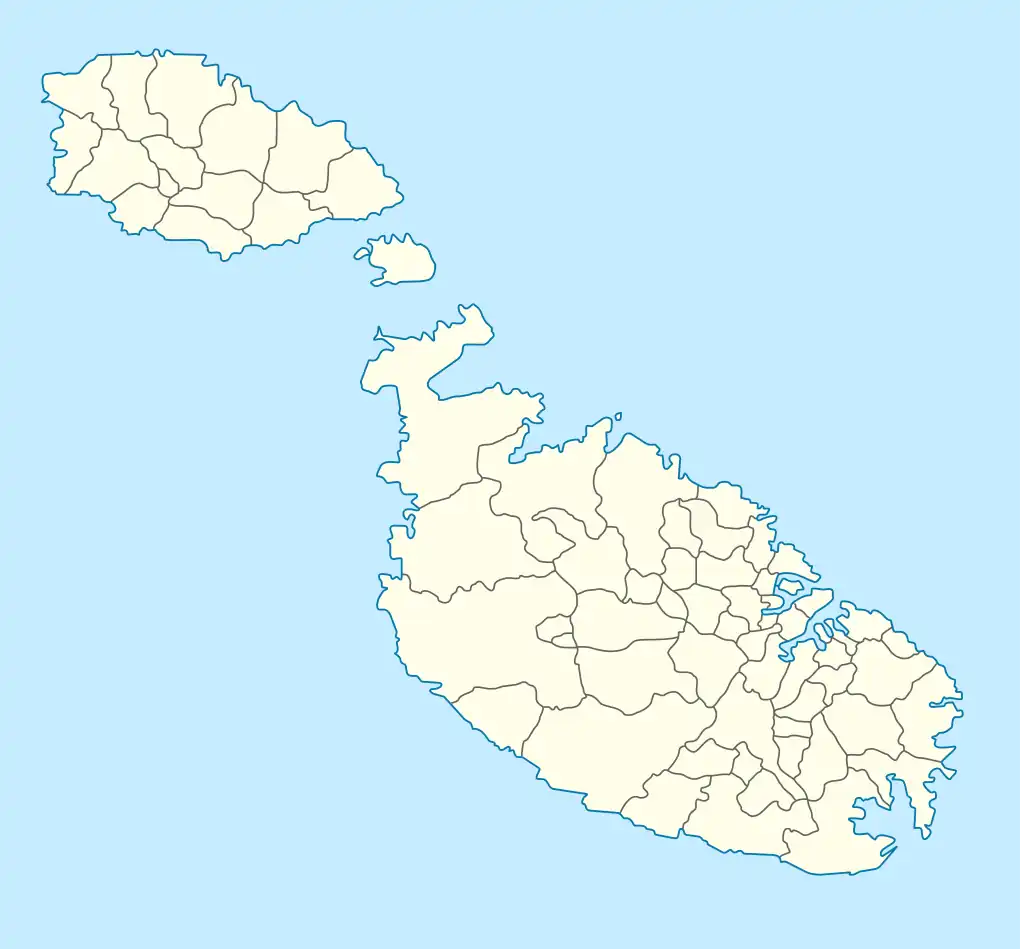Lascaris towers
The Lascaris Towers (Maltese: Torrijiet ta' Lascaris) are a series of mostly small coastal watchtowers built in Malta by the Order of Saint John between 1637 and 1652. The first seven towers were built around the coast of mainland Malta between 1637 and 1638. Between 1647 and 1652, a large tower was also built on mainland Malta, and two smaller ones were built on Gozo.
| Lascaris Towers | |
|---|---|
Torrijiet ta' Lascaris | |
| Various locations in Malta and Gozo | |
| Type | Coastal watchtowers |
| Site information | |
| Condition | 9 intact 1 destroyed |
| Site history | |
| Built | 1637–1638 1647–1652 |
| Built by | Order of Saint John |
| In use | 1637–20th century |
| Materials | Limestone |
History
Commissioning and construction
The Italian knight Giovanni Paolo Lascaris was elected Grand Master of the Order of St. John on 16 June 1636. Unlike the earlier Wignacourt towers which were personally funded by the Grand Master, the cost of the Lascaris towers was paid by the Università.[1] Construction of the first tower, located at ta' Lippija near Ġnejna, began in 1637. Another six towers were built within the following year.
Six of the seven original towers were coastal watchtowers, built on or near the sites of medieval watch posts.[2][3] The only Lascaris tower which is located inland is the Nadur Tower at Binġemma Gap, which was built to facilitate communication between the other towers and the fortified city of Mdina.[4]
Another tower, Saint Agatha's Tower, was built between 1647 and 1649. Unlike the original towers, this was a large bastioned structure similar to the earlier Wignacourt towers.[5]
The last two towers to be built in Lascaris' reign were the ones at Xlendi and Dwejra. These were built in 1650 and 1652 respectively, and the cost of construction was paid by the Università of Gozo.[6][7]
In 1658 and 1659, Lascaris' successor, Martin de Redin, built another 13 watchtowers around Malta's coastline, which became known as the De Redin towers. The design of the new towers were based on Sciuta Tower. Due to their similarity in design, sometimes the Lascaris and De Redin towers are collectively known as "De Redin towers".
Eighteenth and nineteenth centuries
In around 1715, as part of a programme to improve Malta's coastal defences, Qawra Tower was upgraded into a coastal battery. A gun platform was built around the seaward face of the tower, which served as a blockhouse. At this point, a redan trace entrenchment was built near Saint Agatha's Tower.
Blat Mogħża Tower collapsed in around 1730 when the cliffs on which it was built gave way. The tower was never rebuilt, and no traces of it can be seen today.[3]
In the 1760s, entrenchments were built near Qawra Tower.
Most of the towers were decommissioned in the 19th century, but some saw use again in World War II.
Conservation and restoration
By the end of the 20th century, most of the nine surviving towers were in a rather dilapidated state. St. Agatha's Tower and Lippija Tower were in a particularly bad state, and were in danger of collapsing.
St. George's Tower, Dwejra Tower, St. Agatha's Tower, Għajn Tuffieħa Tower and Lippija Tower were all restored between the late 1990s and 2013. Xlendi Tower is currently being restored, while plans are also being made for the restoration of Sciuta Tower.
Today, Għajn Tuffieħa, St. Agatha's and Dwejra Towers are open to the public. St. George's Tower is within the grounds of a hotel, and Qawra Tower is open as a restaurant.
The towers
| Name | Image | Location | Built | Status |
|---|---|---|---|---|
| Lippija Tower | 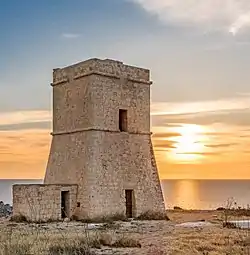 | Mġarr | 1637 | Intact |
| Għajn Tuffieħa Tower |  | Mġarr | 1637 | Intact |
| Blat Mogħża Tower | Mġarr | c. 1637 | Collapsed | |
| Nadur Tower |  | Rabat | 1637 | Intact |
| Qawra Tower | 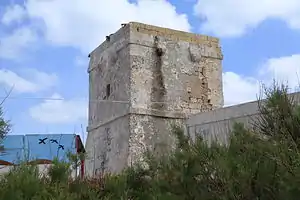 | St. Paul's Bay | 1638 | Intact |
| Sciuta Tower |  | Qrendi | 1638 | Intact |
| Saint George's Tower | 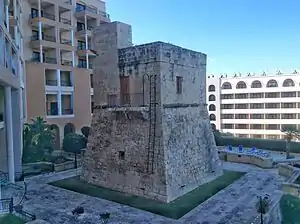 | St. Julian's | 1638 | Intact |
| Saint Agatha's Tower | 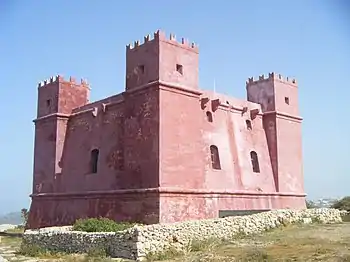 | Mellieħa | 1647-9 | Intact |
| Xlendi Tower | 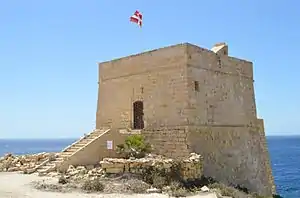 | Munxar | 1650 | Intact |
| Dwejra Tower |  | San Lawrenz | 1652 | Intact |
References
- Zammit, Vincent (1992). Il-Gran Mastri - Ġabra ta' Tagħrif dwar l-Istorja ta' Malta fi Żmienhom - L-Ewwel Volum 1530-1680 (in Maltese). Valletta: Valletta Publishing & Promotion Co. Ltd. p. 212.
- Zammit, Vincent (1984). "Fortifications in the Middle Ages". Civilization. Ħamrun: PEG Ltd. 1: 33.
- Spiteri, Stephen C. "Naxxar and its fortifications". MilitaryArchitecture.com. Archived from the original on 20 January 2016. Retrieved 17 May 2015.
- "Nadur Tower" (PDF). National Inventory of the Cultural Property of the Maltese Islands. 30 March 2012. Archived from the original (PDF) on April 3, 2015. Retrieved 22 June 2015.
- Spiteri, Stephen C. (2013). "In Defence of the Coast (I) - The Bastioned Towers". Arx - International Journal of Military Architecture and Fortification (3): 83–89, 100–108. Archived from the original on 15 September 2017. Retrieved 22 June 2015.
- "Xlendi Tower, Munxar, Gozo". Din l-Art Ħelwa. 6 October 2011. Retrieved 22 June 2015.
- "Dwejra Tower, Gozo". Din l-Art Ħelwa. 10 October 2011. Retrieved 22 June 2015.

